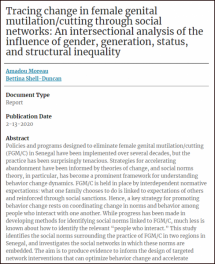Tracing Change in Female Genital Mutilation/Cutting through Social Networks: An Intersectional Analysis of the Influence of Gender, Generation, Status, and Structural Inequality
Policies and programs designed to eliminate female genital mutilation/cutting (FGM/C) in Senegal have been implemented over several decades, but the practice has been surprisingly tenacious.
Strategies for accelerating abandonment have been informed by theories of change, and social norms theory, in particular, has become a prominent framework for understanding behavior change dynamics. FGM/C is held in place by interdependent normative expectations: what one family chooses to do is linked to expectations of others and reinforced through social sanctions. Hence, a key strategy for promoting behavior change rests on coordinating change in norms and behavior among people who interact with one another.
While progress has been made in developing methods for identifying social norms linked to FGM/C, much less is known about how to identify the relevant “people who interact.” This study identifies the social norms surrounding the practice of FGM/C in two regions in Senegal, and investigates the social networks in which these norms are embedded. The aim is to produce evidence to inform the design of targeted network interventions that can optimize behavior change and accelerate abandonment of FGM/C.
Source: Population Council
Date of Publication: March 10, 2021
SIMILIAR RESOURCES
Tools
Examples
- WHO Guidelines on the Management of Health Complications from Female Genital Mutilation
- Fact Sheet on FGM
- Health Risks of FGM
- Responding to Female Genital Mutilation: A Guide for Key Professionals
- Female Genital Mutilation and Behaviour Change
- Toolkit for Engaging Midwives in the Global Campaign to End FGM
- The Girl Generation: Do No Harm Guidance Note
- Behavior Change to End FGM
- The REPLACE Approach: Supporting Communities to End FGM
- Do Your Own Survey: How to Collect Data on FGM

